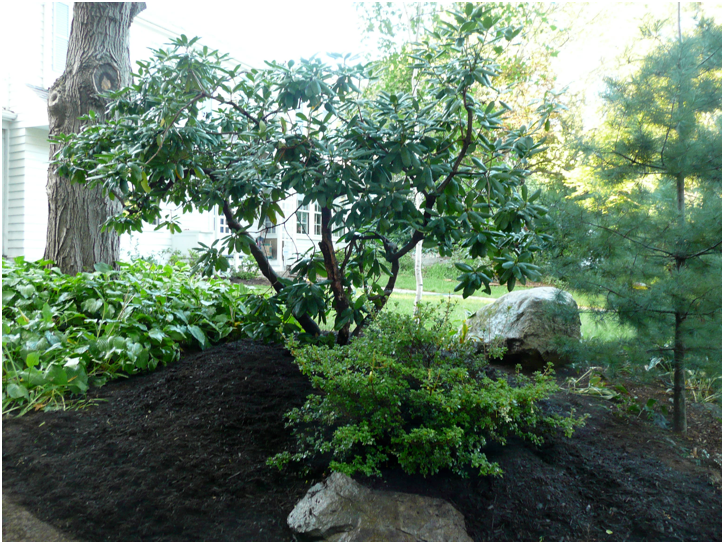DeMystifying Design...
What is Most Important FIRST?
(Answer after portfolio below)
DESIGN PORTFOLIO
A sampling of some elaborate-to-simple projects in Eastern Mass. during the last 8 years…
from a “hardscape” walkway to “softscape” plantings of garden perennials, shrubs & trees…
HARDSCAPE A brick walkway installed at a townhouse in Cambridge, Mass., planted with
upright evergreens, ‘Emerald’ arborvitae (Thuja) & ‘Sky Pencil’ Japanese Holly (Ilex crenata);
with herbaceous Astilbe, Heuchera & Hosta, planting in progress… adding ferns and Hellebores.
“We came home late last night so I didn’t get a chance to see the gardens until today.
Wow! Everything looks fantastic! Thanks so much for your terrific work. We’re
absolutely delighted with the results. Thanks again, Valerie”


Hillside Garden
Created in 2006 for Weston Nurseries of Hopkinton, Mass. ABOVE, a boulder stream with water flowing past a
multi-stem River Birch (Betula), a wide-spreading Microbiota at its base and flowering sweetspire (Itea) at left.
BELOW, fall-colorful Itea in background and a Miscanthus ornamental grass leaning over the pond.

PLANTINGS I enhanced a foundation of existing shrubs in Ashland, Mass., with herbaceous garden
garden perennials, as this gracefully arching Miscanthus ornamental grass (also a young Japanese
maple tree / Acer Palmatum). Green bed at left is robust Grapeleaf Anemone vitifolia ‘Robustissima’,
blooming profusely from July 4th until frost, and very vigorously, not for small gardens…
Interplanted with other flowers: a very fragrant, bright pink peony (Paeonia) blooming in spring within the
bed, underplanted with earlier flowers of creeping pink Phlox subulata. Lilies blooming early summer within
the bed of barely blooming grapeleaf Anemone: a very fragrant red, pink & white ‘Stargazer’ Lily (Lilium,
true lily from a bulb) and orange daylilies (Hemerocallis); grapeleaf Anemone in full bloom.
A bearded Iris germanica blooming in spring next to a small newly-planted dwarf Azalea (Rhododendron
‘Chinzan’) in pink bud, a zone 7 trial in Ashland.







Tough, beautiful fall-blooming Cimicifuga (now Actaea) in another Ashland garden


LIGHTPOST PLANTING in Shrewsbury, Mass., with a new dogwood tree
(Cornus kousa), some colorful daylilies (Hemerocallis), Sedum ‘Autumn Fire’ and
Miscanthus ‘Morning Light’ ornamental grass. Client wanted room to plant annuals and
space between groupings. It’s not always about what I like to see, a denser nesting of
plants, but what a client wants. This is also a young garden in its 3rd year... shrubs take 5 to
7 years to mature, trees take decades.
Below at other end: a clump serviceberry tree (Amelanchier) with a row of sweetspire (Itea),
more daylilies and a small purple-leafed Japanese maple (Acer palmatum)

SUMMER COLOR A house in Jamaica Plain (Boston), Mass., gains more summer color with a
purple-leafed ‘Forest Pansy’ redbud tree (Cercis), red ‘Knock Out’ rose (Rosa) & purple ‘Jackmanii’ Clematis

TRANSPLANTING
A mature Rhododendron maximum in Newton, Mass., being moved
...note the large pancake of shallow roots on burlap...
to front yard with an azalea, allowing renovation of the side porch












